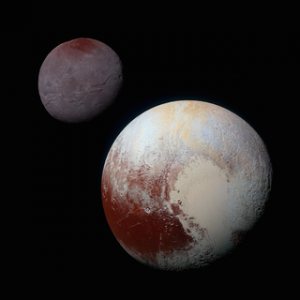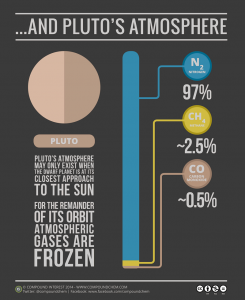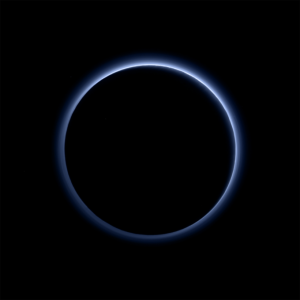Uncovering Pluto and Beyond
Andrew Koller, Madisson Osmak, Miguel Elsaid
Introduction – Early Discoveries about Pluto

Pluto’s Surface. Source: https://www.nasa.gov/audience/forstudents/k-4/stories/nasa-knows/what-is-pluto-k4.html
Pluto was part of our Planet Family for a long time, as the 9th planet in our Solar System since its discovery in 1930 by Clyde Tombaugh.1 However nearly eight decades later in 2006, Pluto was reclassified as a dwarf Planet by the International Astronomical Union (IAU). One of the reasons for this is that it does not meet the criteria, specifically “clearing its own neighbourhood.” This means that Pluto has become gravitationally dormant; there are no other bodies under its gravitational influence other than its own satellites.2 Pluto is now considered to be just one of many Dwarf Planets found in the Kuiper Belt. The Kuiper Belt is a large region of asteroids and other debris in the shape of a ring outside the radius of Neptune’s orbit. Pluto is one of the largest Dwarf planets in the Kuiper Belt. This paper will discuss all the findings on Pluto, and the technological advances that brought about these findings. This paper will also unpack NASA’s New Horizons Missions, its instruments and new discoveries.
The New Horizons Mission
The New Horizon’s mission was launched with the intent to expand our very limited knowledge about Pluto and what lies beyond. The mission was launched on January 19, 2006.3 NASA sent out a spacecraft with various instruments to lead the path for the uncovering of the mysteries of the Kuiper Belt. The spacecraft was equipped with seven instruments, each with a distinct task that allows the spacecraft to explore things individually: Ralph, Alice, REX, SWAP, PESPSSI, and SDS. An astonishing discovery is credited to Ralph which revealed that Pluto possesses blue skies, as will be discussed in the next portion. Ralph is an infrared and visible imager that can take coloured pictures and thermal maps.4 The New Horizons mission’s aim is to map the surfaces and study the composition and geology of what many space scientists consider a double planet. Pluto-Charon is the double planet they are referring to because they are viewed to be so close together, scientists term it a double planet.5 This mission was ranked the number one priority mission in the entire NASA organization, as a result of the many questions and few answers we have about the Kuiper Belt. Success of the New Horizons mission will shed light on a not so new class of bodies in the solar system, but a newly explored class of bodies – dwarf pants, and will provide other valuable contributions to planetary science such as what other dwarf planets consist of, if they also have moons orbiting around them, or if we will eventually be able to find our 9th planet.6 In 2015, the spacecraft reached the newly reclassified dwarf planet, Pluto. Through its first mission to Pluto, we have learned that Pluto is a little different. Pluto is only about two-thirds as wide as Earth’s moon and its surface is one of the coldest places in the solar system at roughly -225 degrees celsius.7 Pluto’s surface is covered mostly by nitrogen and methane and is also covered in an abundance of methane ice and mountains that reach as high as 3352 meters and those are just some features that makes Pluto different than the rest of the planets included in our Solar System.8 From the images captured, it shows that Pluto’s atmosphere appears blue in colour.

Pluto’s atmospheric composition. Source: http://pluto.jhuapl.edu/News-Center/PI-Perspectives.php?page=piPerspective_01_23_2015
Pluto’s Atmosphere
Pluto is billions of kilometres away so, of course studying it is a challenge.1 It was a challenge to determine if Pluto had an atmosphere or not. It was confirmed that Pluto has an atmosphere when astrophysicists noticed that stars dim as Pluto is close to them (using Ralph and LORRI), indicating the atmosphere is blocking off some light.9 Pluto’s atmosphere is roughly 90% Nitrogen and 10% other complex molecules such as methane along with some carbon monoxide which is learned from the exploration of New Horizons.10
New Technological Advancements

New Horizon’s Spacecraft instruments used on its mission to Pluto. Source: https://www.nasa.gov/mission_pages/newhorizons/spacecraft/index.html
The New Horizons team had specific goals in mind when it came to researching Pluto and the Kuiper Belt. The first goal was just reaching the dwarf planet within a specific area and time frame to allow for good data collection. Other main goals that the project included were getting high resolution photographs of the surface of Pluto, measuring composition of the atmosphere and surface of the planet, and observing what exactly lies within the Kuiper Belt.11 The components that the probe utilizes to achieve these goals are as follows:
Visible and Infrared light imager and spectrometer (Ralph):
This provides colour, composition, and thermal maps.12
Ultraviolet light spectrometer (Alice):
This focuses on analysis of the composition and structure of Pluto’s atmosphere and looks for other atmospheres around other Kuiper Belt Objects.12
Radio Science Experiment (REX):
This is a passive radiometer that measures microwaves emitted from the surface of an object.13 The advantage to REX is that the measurements it takes from microwaves are less affected by clouds.13 REX measures composition and temperature of atmospheres.12
Long Range Reconnaissance Imager (LORRI):
This telescopic camera can obtain data to map things like Pluto’s far side and provide scientists with high resolution geologic data. The camera is designed to minimize any stray light and also protect itself from radiation in space. Many of the main images downloaded from New Horizons are possible thanks to LORRI.12
Solar Wind Around Pluto (SWAP):
This solar wind and plasma spectrometer measures atmospheric escape rate and observes the interaction of solar wind with Pluto.12
Pluto Energetic Particle Spectrometer Science Investigation (PEPSSI):
This energetic particle spectrometer measures the density and composition of any ions escaping Pluto’s atmosphere.12
Student Dust Counter (SDC):
This measures collisions with space dust that New Horizons encounters during its voyage. The device was built and is operated by students.12
Pluto’s Blue Skies and Water

Pluto’s Blue Atmosphere. Source: https://www.express.co.uk/news/science/610802/ICE-ON-PLUTO-Frozen-water-and-blue-skies-found-on-dwarf-planet
Some people questioned the composition of Pluto’s atmosphere, but as New Horizons has confirmed, the sky is in fact blue. Pluto’s Blue haze is very similar to Neptune’s, Uranus’, and Earth’s atmospheres. The particles that make up the atmosphere the atmosphere and produce this haze are tiny particles which are mostly N2 with trace amounts of CH4 and CO and these particles are most likely to be grey or red in colour,14 and result in a blue colour from scattering of light of these very small particles in a way that makes it so distinct.
On Earth, these particles are very tiny nitrogen molecules, but on Pluto, they appear to be larger and are called tholins, which are essentially organic molecules that scientists believe came from the ultraviolet light breaking up the methane and nitrogen in the atmosphere.10
Another astonishing piece of information, is that there are observations that suggest that Pluto is geologically active. The first is that not all the ice on Pluto is just frozen nitrogen, but some is water ice built into very large mountains.11 One area on Pluto in particular contains a large heart-shaped lobe named Sputnik Planum that has no visible crater impacts. Because it is known based on other areas of Pluto that meteors have in fact been striking Pluto, the likely explanation for this area with no visible craters is that the dwarf planet is still geologically active and therefore the surface has been reformed.20
The Kuiper Belt

Depiction of the Kuiper Belt’s position relative to our Solar System. Source: https://space-facts.com/kuiper-belt/
With New Horizons, we are now able to identify more objects in and around the Kuiper Belt and also what comprises the Kuiper Belt. Essentially the Kuiper Belt is a doughnut-shaped ring of icy object orbiting around the Sun.15 It hold trillions of objects, mostly remnants of the lost debris of the solar system. The discovery of the first Kuiper Belt Object was Pluto, but the first KBO since Pluto was discovered in 1992 by two astronomers, Dave Jewitt and Jane Luu, and was named after Gerard Kuiper. In a sense, Gereard Kuiper proposed that beyond Neptune may lie a belt of icy objects that we know very little about.16 Pluto was the first true Kuiper Belt object (KBO) to be seen.17 Since New Horizons flew past Pluto in 2015, it continues to go deeper into the icy region and on January 1, 2019, New Horizons spacecraft will fly by the Kuiper Belt object 2014 MU69, which may be two objects locked together by gravity.11
The existence of “Planet Nine” was proposed in January of 2016 and it was believed to have 10 times the mass of Earth. Determining the true existence of the so-called “Planet Nine” has now become the New Horizons spacecrafts new goal as it continues into the Kuiper Belt. Such a hypothetical idea has come from the evidence that a handful g KBOs are tiled about 30 degrees downward and by using computer simulations of the solar system with a “Planet Nine”, they believe that this “Planet Nine” might be the influence behind the tilted planets of our solar system.18
Another question facing New Horizons with respect to the Kuiper Belt is whether or not objects in that region are responsible for bringing water to the inner solar system.17 This theory is supported primarily by the amount and size of Kuiper Belt Objects that are very ice-rich, meaning contain a lot of or are entirely composed of ice. Smaller meteorites do not contain large enough quantities of ice to contribute significantly to water content on planets such as Earth given the quantity of water in Earth’s oceans. It was estimated by the Institute of Astronomy at the University of Hawaii that a comet with a diameter of at least 600 miles would have been needed to contribute enough water to help fill the Earth’s oceans and there is no known location of any comets of this size other than the Kuiper Belt.21 Additionally, calculations have shown that Kuiper Belt Objects have in the past broke free of their orbits within the Kuiper Belt and entered the inner solar system.21
Conclusion
The New Horizons mission has provided us with many things; the first ever high resolution images of Pluto’s surface, data on its temperature, and data on its atmospheric composition. All of these discoveries have only been possible thanks to this spacecraft making the journey out to the dwarf planet. The Kuiper Belt was only suggested in the 1950s, a time where this mission would have been unheard of. Now, thanks to the launch of New Horizons in 2006, the New Horizons team has made all of these observations and discoveries. Pluto may not formally be classified as a planet anymore, but that does not change its significance in the context of the rest of the Kuiper Belt Objects. Questions such as the origin of water in the inner solar system are still being examine by the New Horizons Spacecraft.
References
- Dunbar, NASA (2015) https://www.nasa.gov/audience/forstudents/k-4/stories/nasa-knows/what-is-pluto-k4.html.
- Library of Congress https://www.loc.gov/rr/scitech/mysteries/pluto.html
- Tricia Talbert, “Spacecraft and instruments” NASA
- A. Stern, “Journey to the Farthest Planet.” Scientific American 286, no. 5 (2002): 56-63.3.
- Schilling, “Long Trek to Solar System’s Last Frontier Begins.” Science 311, no. 5758 (2006): 172.
- A. Stern, “Journey to the Farthest Planet.” Scientific American 286, no. 5 (2002): 56-63.3.
- Charles Q. Choi, ”Dwarf Planet Pluto: Facts about the icy former planet, https://www.space.com/43-pluto-the-ninth-planet-that-was-a-dwarf.html.
- Lillian Gibson, “New Horizons Finds Blue Skies and Water Ice on Pluto” NASA, 6th August 2017
- Nola Redd, “Does Pluto have an atmosphere” space.com, February 20, 2016.
- “Windows to the Universe,” https://www.windows2universe.org/pluto/pluto_composition.html, Acessed March 30, 2017.
- New Horizons Team | NASA https://www.nasa.gov/mission_pages/newhorizons/overview/index.html
- New Horizons Team | NASA https://www.nasa.gov/mission_pages/newhorizons/spacecraft/index.html
- S. Chen, Space Remote Sensing Systems 152 (1985)
- NASA, https://solarsystem.nasa.gov/solar-system/kuiper-belt/overview/
- NASA, https://solarsystem.nasa.gov/solar-system/kuiper-belt/in-depth/
- Space, https://www.space.com/16144-kuiper-belt-objects.html
- NASA, https://solarsystem.nasa.gov/solar-system/kuiper-belt/in-depth/
- Samantha Mathewson, “Planet Nine Could Be Our Solar System’s Missing “Super Earth,” https://www.space.com/38431-new-evidence-planet-nine-existence.html.
- Sarah Fecht, “Pluto has Red Ice and Blue Skies,” https://www.popsci.com/pluto-has-blue-skies-and-red-water-ice, March 30, 2018
- A. Micu, ZME Science (2015) https://www.zmescience.com/science/geology/pluto-geologically-active-2842342/
- D. Jewitt, No. 9 – Fall 2003: Water: From Comets to the Sea? (2003) http://www2.ifa.hawaii.edu/newsletters/article.cfm?a=121&n=8